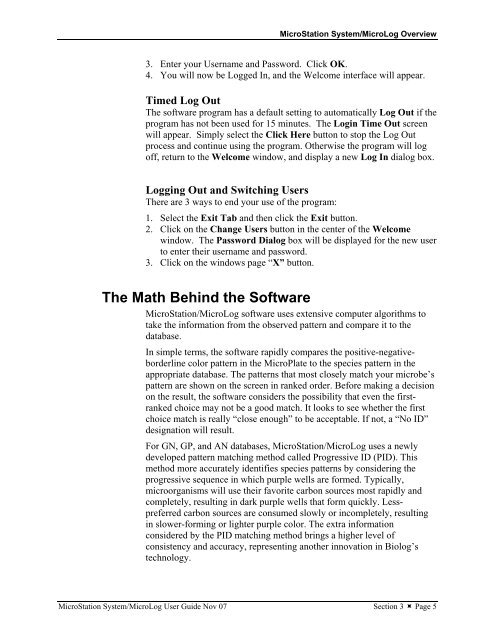MicroStation System, MicroLog Version 4.2 - DTU Systems Biology ...
MicroStation System, MicroLog Version 4.2 - DTU Systems Biology ...
MicroStation System, MicroLog Version 4.2 - DTU Systems Biology ...
You also want an ePaper? Increase the reach of your titles
YUMPU automatically turns print PDFs into web optimized ePapers that Google loves.
<strong>MicroStation</strong> <strong>System</strong>/<strong>MicroLog</strong> Overview<br />
3. Enter your Username and Password. Click OK.<br />
4. You will now be Logged In, and the Welcome interface will appear.<br />
Timed Log Out<br />
The software program has a default setting to automatically Log Out if the<br />
program has not been used for 15 minutes. The Login Time Out screen<br />
will appear. Simply select the Click Here button to stop the Log Out<br />
process and continue using the program. Otherwise the program will log<br />
off, return to the Welcome window, and display a new Log In dialog box.<br />
Logging Out and Switching Users<br />
There are 3 ways to end your use of the program:<br />
1. Select the Exit Tab and then click the Exit button.<br />
2. Click on the Change Users button in the center of the Welcome<br />
window. The Password Dialog box will be displayed for the new user<br />
to enter their username and password.<br />
3. Click on the windows page “X” button.<br />
The Math Behind the Software<br />
<strong>MicroStation</strong>/<strong>MicroLog</strong> software uses extensive computer algorithms to<br />
take the information from the observed pattern and compare it to the<br />
database.<br />
In simple terms, the software rapidly compares the positive-negativeborderline<br />
color pattern in the MicroPlate to the species pattern in the<br />
appropriate database. The patterns that most closely match your microbe’s<br />
pattern are shown on the screen in ranked order. Before making a decision<br />
on the result, the software considers the possibility that even the firstranked<br />
choice may not be a good match. It looks to see whether the first<br />
choice match is really “close enough” to be acceptable. If not, a “No ID”<br />
designation will result.<br />
For GN, GP, and AN databases, <strong>MicroStation</strong>/<strong>MicroLog</strong> uses a newly<br />
developed pattern matching method called Progressive ID (PID). This<br />
method more accurately identifies species patterns by considering the<br />
progressive sequence in which purple wells are formed. Typically,<br />
microorganisms will use their favorite carbon sources most rapidly and<br />
completely, resulting in dark purple wells that form quickly. Lesspreferred<br />
carbon sources are consumed slowly or incompletely, resulting<br />
in slower-forming or lighter purple color. The extra information<br />
considered by the PID matching method brings a higher level of<br />
consistency and accuracy, representing another innovation in Biolog’s<br />
technology.<br />
<strong>MicroStation</strong> <strong>System</strong>/<strong>MicroLog</strong> User Guide Nov 07 Section 3 � Page 5


